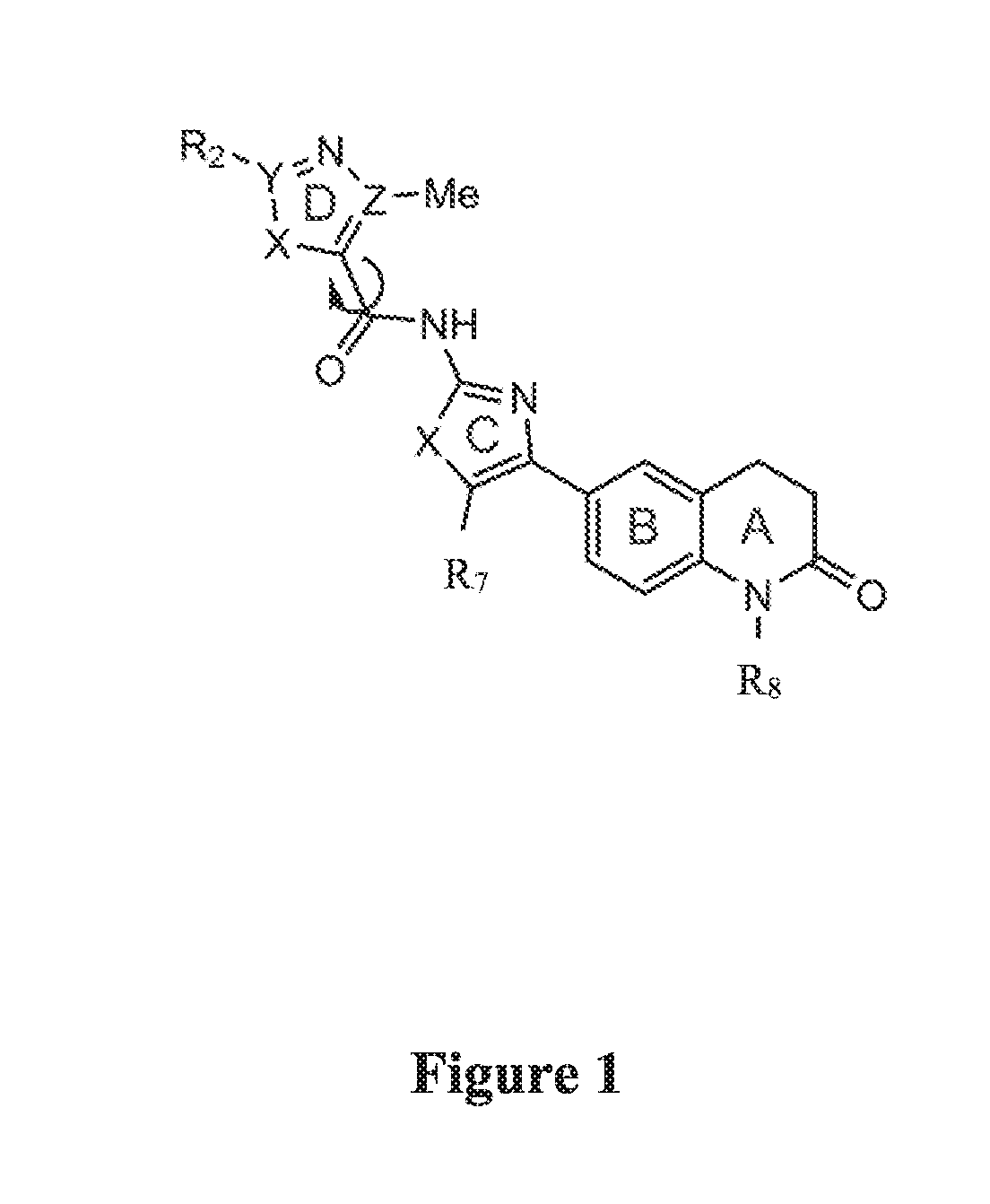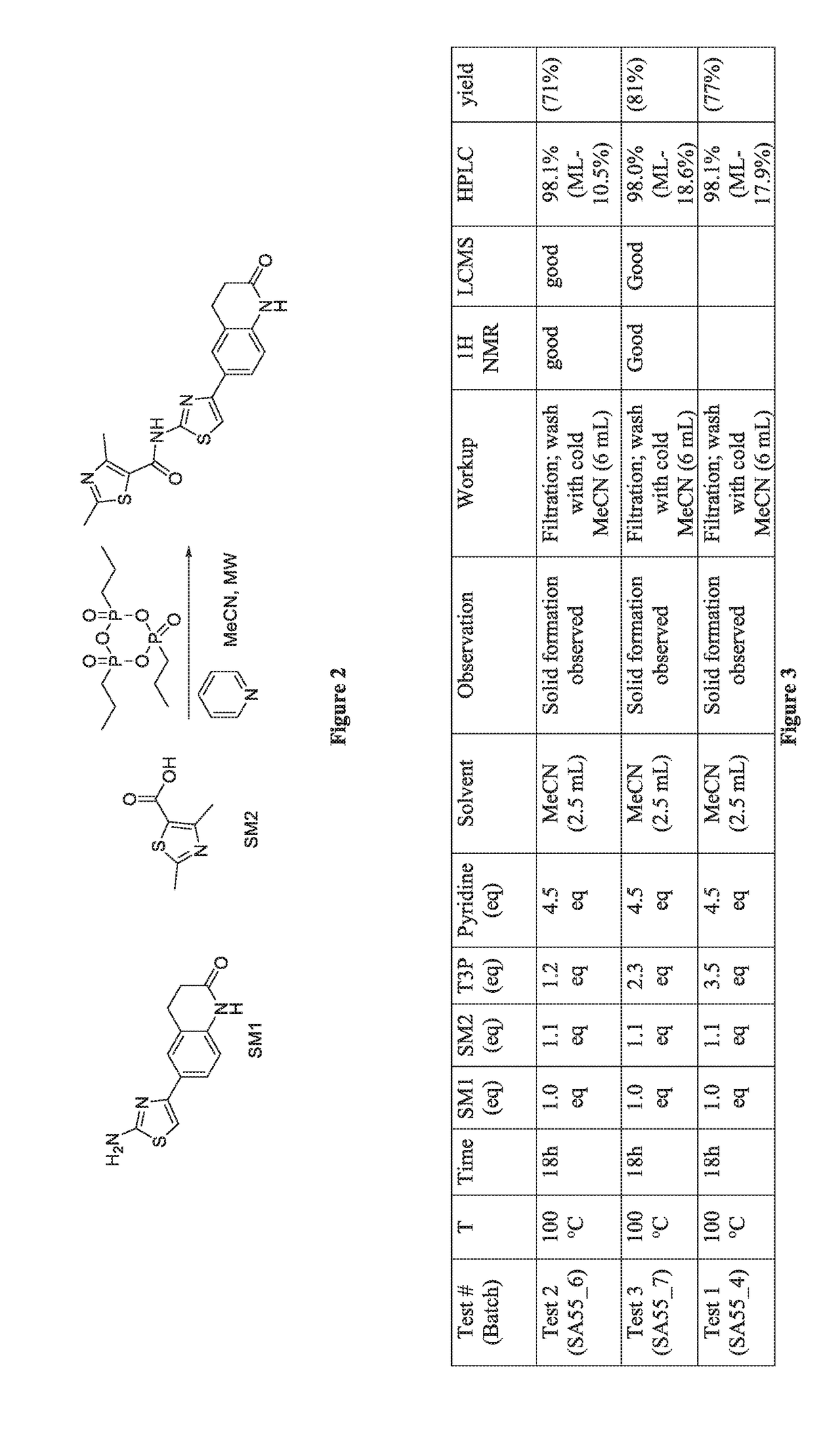Compositions and methods of targeting mutant k-ras
a technology of mutant k-ras and composition, applied in the field of pharmaceutical compounds, can solve the problem that the report did not distinguish between different mutant forms, and achieve the effect of reducing downstream signaling
- Summary
- Abstract
- Description
- Claims
- Application Information
AI Technical Summary
Benefits of technology
Problems solved by technology
Method used
Image
Examples
example 1
[0100]
[0101]To a suspension of 6-(2-aminothiazol-4-yl)-3,4-dihydroquinoiolin-2(1H)-one (0.050 g, 0.203 mmol) and 2,4-dimethylthiazole-5-carboxylic acid (0.035 g, 0.224 mmol), and pyridine (0.06 mL, 0.713 mmol) in acetonitrile (2 mL) in a sealed tube was added propylphosphonic anhydride solution (50 wt % in ethyl acetate, 0.29 mL, 0.489 mmol). The sealed tube was heated to 48.5° (C for 4 days and the precipitation formed. After cooling, the solid was collected by filtration and washed with cold dichloromethane to give 2,4-dimethyl-N-(4-(2-oxo-1,2,3,4-tetrahydroquinolin-6-yl)thiazol-2-yl)thiazole-5-carboxamide (0.045 g, 58%) as a beige solid. 1H NMR (400 MHz, DMSO-d): δ 12.58 (bs, 1H), 10.18 (s, 1H), 7.74 (s, 1H), 7.69 (dd, 1H, J=8.4, 1.6 Hz), 7.45 (bs, 1H), 6.88 (d, 1H, J=8.4 Hz), 2.93 (m, 2H), 2.66 (s, 3H), 2.61 (s, 3H), 2.48 (partial masked under d-DMSO, m, 2H). MS (ESI): Calcd. for C18H16N4O2S2: 384, found 385 (M+1)+.
example 2
[0102]
[0103]To a suspension of 6-(2-aminothiazol-4-yl)-3,4-dihydroquinolin-2(1H)-one (0.100 g, 0.408 mmol) and 2-ethyl-4-methyl-1,3-thiazole-5-carboxylic acid (0.077 g, 0.448 mmol), and pyridine (0.15 mL, 1.832 mmol) in acetonitrile (4 mL) in a sealed tube was added propylphosphonic anhydride solution (50 wt % in ethyl acetate, 0.85 mL, 1.432 mmol). The sealed tube was heated to 50° C. for 5 days and the precipitation formed. After cooling, the precipitate was collected by filtration and washed with cold 1:1 acetonitrile / water to give 2-ethyl-4-methyl-N-(4-(2-oxo-1,2,3,4-tetrahydroquinolin-6-yl)thiazol-2-yl)thiazole-5-carboxamide (0.094 g, 58%) as a beige solid. 1H NMR (400 MHz, DMSO-d): δ 12.56 (bs, 1H), 10.19 (s, 1H), 7.74 (s, 1H), 7.69 (dd, 1H, J=8.4, 1.6 Hz), 7.51 (bs, 1H), 6.89 (d, 1H, J=8.4 Hz), 2.99 (q, 2H, J=7.6 Hz), 2.93 (m, 2H), 2.62 (s, 3H), 2.49 (partial masked under d-DMSO, m, 2H), 1.32 (t, 3H, J=7.6 Hz), MS (ESI): Calcd. for C19H18N4O2S2: 398, found 399 (M+1)+.
example 3
[0104]
[0105]To a suspension of 6-(2-amino-5-chlorothiazol-4-yl)-3,4-dihydroquinolin-2(1H)-one hydrochloride (0.100 g, 0.408 mmol) and 4-methyl-2-(propan-2-yl)-1,3-thiazole-5-carboxylic acid (0.083 g, 0.448 mmol), and pyridine (0.15 m L, 1.831 mmol) in acetonitrile (4 mL) in a sealed tube was added propylphosphonic anhydride solution (50 wt % in ethyl acetate, 0.85 mL, 1.431 mmol). The sealed tube was heated to 50° C. for 5 days and the precipitation formed. After cooling, the precipitate was collected by filtration and washed with cold 1:1 acetonitrile / water to give 2-isopropyl-4-methyl-N-(4-(2-oxo-1,2,3,4-tetrahydroquinolin-6-yl)thiazol-2-yl)thiazole-5-carboxamide (0.104 g, 62%) as a beige solid. 1H NMR (400 MHz, DMSO-d): δ 12.56 (bs, 1H), 10.19 (s, 1H), 7.74 (s, 1H), 7.69 (dd, 1H, J=8.4, 1.6 Hz), 7.51 (s, 1H), 6.89 (d, 1H, J=8.4 Hz), 3.29 (m, 1H), 2.93 (m, 2H), 2.62 (s, 3H), 2.49 (partial masked under d-DMSO, m, 2H), 1.36 (s, 3H), 1.34 (s, 3H). MS (ESI): Calcd. for C20H20N4O2S2: 4...
PUM
 Login to View More
Login to View More Abstract
Description
Claims
Application Information
 Login to View More
Login to View More - R&D
- Intellectual Property
- Life Sciences
- Materials
- Tech Scout
- Unparalleled Data Quality
- Higher Quality Content
- 60% Fewer Hallucinations
Browse by: Latest US Patents, China's latest patents, Technical Efficacy Thesaurus, Application Domain, Technology Topic, Popular Technical Reports.
© 2025 PatSnap. All rights reserved.Legal|Privacy policy|Modern Slavery Act Transparency Statement|Sitemap|About US| Contact US: help@patsnap.com



